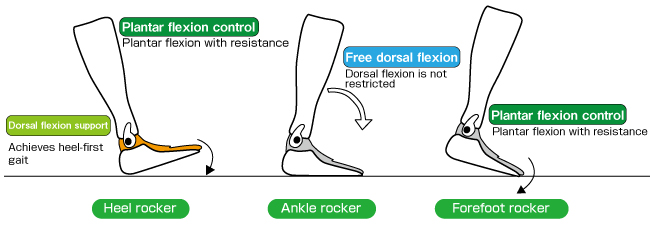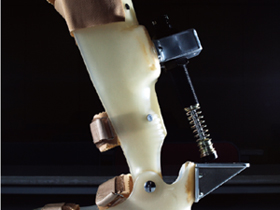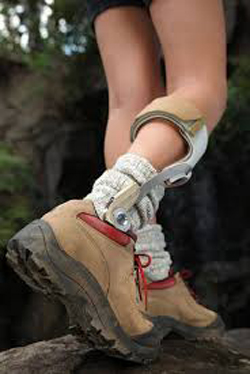
"Is it comfortable to walk with the ankle joint fixed?"
This question from Sumiko Yamamoto, a professor of Graduate School International University of Health and Welfare, was a point of departure.
New orthosis development started from this one question
"The ankle joint shoulde be fixed by the orthosis to lift toe off."
It was common in orthosis for hemiplegia patients.
"Is it comfortable to walk with the ankle joint fixed?" This question from Sumiko Yamamoto, Prof. of Graduate School International University of Health and Welfare,was a point of departure for Gait Solution(GS).
Pursuit of the answer brought us to a simple solution
We want to make "orthosis for comfortable walk" rather than "orthosis to avoid tripping."
GS does not aim to compensate but to reconstruct gait.
Gait analysis of over 100 healthy subjects and hemiplegia patients leads to the answer; only minimum support is required for comfortable walk.
"Minimum support" means support only for functions of the dorsal flexion muscles at the ankle joint.
In other words, only three functions are required.
 Prof.Yamamoto arrived at a very simple answer.
Prof.Yamamoto arrived at a very simple answer.
This question from Sumiko Yamamoto, a professor of Graduate School International University of Health and Welfare, was a point of departure.
New orthosis development started from this one question
"The ankle joint shoulde be fixed by the orthosis to lift toe off."
It was common in orthosis for hemiplegia patients.
"Is it comfortable to walk with the ankle joint fixed?" This question from Sumiko Yamamoto, Prof. of Graduate School International University of Health and Welfare,was a point of departure for Gait Solution(GS).
Pursuit of the answer brought us to a simple solution
We want to make "orthosis for comfortable walk" rather than "orthosis to avoid tripping."
GS does not aim to compensate but to reconstruct gait.
Gait analysis of over 100 healthy subjects and hemiplegia patients leads to the answer; only minimum support is required for comfortable walk.
"Minimum support" means support only for functions of the dorsal flexion muscles at the ankle joint.
In other words, only three functions are required.

Plantar flexion control:
Supports eccentric contraction functions of the dorsal flexion muscles at the ankle joint during the beginnings of stance phase.
Free corsal flexion:
Not interfere motions after the heel rocker
Dorsal flexion support:
Provides toe clearance from the floor during swing phase
The first orthosis that achieves "comfortable walk"
 "Momentary strong force" this is required for the breaking force to support the heel rocker.
Most of traditional ankle foot orthosis with plantar flexion control function incorporate a spring type of plantar flexion control mechanism. At the beginning of GS development, we also adopt a spring type. However, very large spring is required to compensate the necessary force to support the heel rocker during the beginnings of stance phase. The spring projects from the posterior surface of the lower leg on the orthosis, whick interferes to go down stairs, and above all, spoils the appearance significantly.
Therefore, we adopt a hydraulic damper, which can produce a strong force in a moment, as a power source to support the heel rocker during the beginnings of stance phase.
Thus, we developed a hyadraulic mechanism for plantar flexion control to achieve" comfortable walk."
That is "Gait Solution."
"Momentary strong force" this is required for the breaking force to support the heel rocker.
Most of traditional ankle foot orthosis with plantar flexion control function incorporate a spring type of plantar flexion control mechanism. At the beginning of GS development, we also adopt a spring type. However, very large spring is required to compensate the necessary force to support the heel rocker during the beginnings of stance phase. The spring projects from the posterior surface of the lower leg on the orthosis, whick interferes to go down stairs, and above all, spoils the appearance significantly.
Therefore, we adopt a hydraulic damper, which can produce a strong force in a moment, as a power source to support the heel rocker during the beginnings of stance phase.
Thus, we developed a hyadraulic mechanism for plantar flexion control to achieve" comfortable walk."
That is "Gait Solution."
 "Momentary strong force" this is required for the breaking force to support the heel rocker.
Most of traditional ankle foot orthosis with plantar flexion control function incorporate a spring type of plantar flexion control mechanism. At the beginning of GS development, we also adopt a spring type. However, very large spring is required to compensate the necessary force to support the heel rocker during the beginnings of stance phase. The spring projects from the posterior surface of the lower leg on the orthosis, whick interferes to go down stairs, and above all, spoils the appearance significantly.
Therefore, we adopt a hydraulic damper, which can produce a strong force in a moment, as a power source to support the heel rocker during the beginnings of stance phase.
Thus, we developed a hyadraulic mechanism for plantar flexion control to achieve" comfortable walk."
That is "Gait Solution."
"Momentary strong force" this is required for the breaking force to support the heel rocker.
Most of traditional ankle foot orthosis with plantar flexion control function incorporate a spring type of plantar flexion control mechanism. At the beginning of GS development, we also adopt a spring type. However, very large spring is required to compensate the necessary force to support the heel rocker during the beginnings of stance phase. The spring projects from the posterior surface of the lower leg on the orthosis, whick interferes to go down stairs, and above all, spoils the appearance significantly.
Therefore, we adopt a hydraulic damper, which can produce a strong force in a moment, as a power source to support the heel rocker during the beginnings of stance phase.
Thus, we developed a hyadraulic mechanism for plantar flexion control to achieve" comfortable walk."
That is "Gait Solution."
Design that enables to "enjoy" the life
 Althoughe exercise therapy with GS can reconstruct gait, GS has another problem; its design was not good enough for users to "enjoy using."
Thus, we developed a new orthosis paying special attention to the design. This orthosis is Gait Solution Design, which won the Good Design Award.
We succeeded in improving function of the hydraulic damper and also making it smaller.
The ankle unit can be folded into miniaturized form while keeping its function, and it enables to put on various shoes on the orthosis.
Gait Solution Design achieves both of "comfortable walk" and enjoying "fashion."
Althoughe exercise therapy with GS can reconstruct gait, GS has another problem; its design was not good enough for users to "enjoy using."
Thus, we developed a new orthosis paying special attention to the design. This orthosis is Gait Solution Design, which won the Good Design Award.
We succeeded in improving function of the hydraulic damper and also making it smaller.
The ankle unit can be folded into miniaturized form while keeping its function, and it enables to put on various shoes on the orthosis.
Gait Solution Design achieves both of "comfortable walk" and enjoying "fashion."
 Althoughe exercise therapy with GS can reconstruct gait, GS has another problem; its design was not good enough for users to "enjoy using."
Thus, we developed a new orthosis paying special attention to the design. This orthosis is Gait Solution Design, which won the Good Design Award.
We succeeded in improving function of the hydraulic damper and also making it smaller.
The ankle unit can be folded into miniaturized form while keeping its function, and it enables to put on various shoes on the orthosis.
Gait Solution Design achieves both of "comfortable walk" and enjoying "fashion."
Althoughe exercise therapy with GS can reconstruct gait, GS has another problem; its design was not good enough for users to "enjoy using."
Thus, we developed a new orthosis paying special attention to the design. This orthosis is Gait Solution Design, which won the Good Design Award.
We succeeded in improving function of the hydraulic damper and also making it smaller.
The ankle unit can be folded into miniaturized form while keeping its function, and it enables to put on various shoes on the orthosis.
Gait Solution Design achieves both of "comfortable walk" and enjoying "fashion."
NEW challenges
GS was born from one question. Its most unique feature, providing only “the minimum support for gait,” receives much attention in orthosis therapy now. GS has a low risk of inducing abnormal muscle movements, and is suitable to learn the movements of normal gait and muscle movement patterns because GS supports the heel rocker in the similar way to the actual muscle movement. For these reasons, GS is used for gait training from early period. Now, GS begins to play a new role of “supporting gait for hemiplegia patients from acute phase to their daily life.”
GS was born from one question. Its most unique feature, providing only “the minimum support for gait,” receives much attention in orthosis therapy now. GS has a low risk of inducing abnormal muscle movements, and is suitable to learn the movements of normal gait and muscle movement patterns because GS supports the heel rocker in the similar way to the actual muscle movement. For these reasons, GS is used for gait training from early period. Now, GS begins to play a new role of “supporting gait for hemiplegia patients from acute phase to their daily life.”

 GaitSolution
GaitSolution


